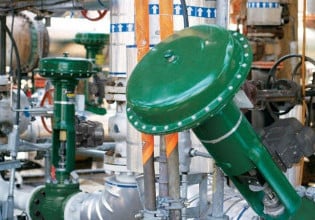Hitachi Energy, TransnetBW Team Up for Supercapacitor Grid Deal
Hitachi Energy partners with TransnetBW to advance renewable energy growth and grid resilience with supercapacitors.
While renewable energy sources offer environmental benefits, their intermittent nature presents challenges in grid integration. As attention shifts towards renewables, grid stability becomes a concern of paramount importance. Consequences of grid instability include power outages, equipment damage, and disruptions to essential services, prompting the need for enhanced grid stabilization measures and investment in resilient infrastructure.
Hitachi Energy has signed a major contract with Germany’s TransnetBW to deploy supercapacitors to enhance and stabilize the power grid. So why is grid instability such a challenge, and how is Hitachi Energy approaching this issue?
High-voltage transmission lines. Image used courtesy of TransnetBW
Grid Stability Significance
Grid stability means maintaining consistent voltage and frequency levels across the entire electrical network to ensure the balanced supply and demand of electricity. This equilibrium prevents disruptions and maintains the reliability of the electrical grid. Any fluctuation in the electrical grid directly affects the end user in terms of equipment damage and high energy bills.
Integrating sources like solar and wind into electrical grids introduces variability and intermittency due to their dependence on natural factors. Traditional grid stability methods relying on synchronous generators offer more predictable outputs, but renewables can cause fluctuations in output based on weather conditions. Addressing these challenges requires advanced grid management techniques and deploying technologies such as energy storage systems and smart grid solutions to accommodate renewable energy integration while maintaining grid stability.
Supercapacitors in an electrical power grid. Image used courtesy of Scientific Research
One method to stabilize the grid is to deploy supercapacitors to serve as energy storage systems in microgrids. Offering faster charging and discharging rates than conventional batteries, supercapacitors efficiently store surplus power during low-demand periods and release it during high-demand periods, effectively managing peak loads and stabilizing grid voltage. Supercapacitors support active and reactive power compensation, ensuring grid stability and smoothing fluctuations. Their rapid energy absorption and release capabilities make them a promising solution for addressing transient issues such as voltage fluctuations caused by system failures.
Supercapacitors for a Carbon-Neutral Energy Landscape
Hitachi Energy recently struck a major deal with TransnetBW, a German state-owned transmission system operator, to enhance grid stability with renewable energy integration.
The agreement involves delivering two enhanced supercapacitor-based static synchronous compensator (STATCOM) stations featuring Hitachi Energy's advanced grid stabilization technology, SVC Light Enhanced. These stations will improve power quality across TransnetBW's transmission grid, serving approximately 11 million individuals and numerous industries.
Video used courtesy of Hitachi Energy
Hitachi Energy's integrated system combines vital power quality and grid stabilization technologies in a compact unit. By blending SVC Light's efficient reactive power compensation with supercapacitors, it swiftly manages active power flow. Moreover, enhanced with advanced control features like Grid Forming Control, this solution offers a significant 40 percent reduction in carbon footprint. It also adapts to future network changes. Addressing the challenges of renewable energy integration, it expands transmission capacity without additional infrastructure, ensuring power grid stability amid rising renewable energy penetration.
Looking Ahead at Grid Stabilization
Without energy storage devices like supercapacitors, the power grid needs large peaker plants to ensure grid stability. Ultimately, the solution of introducing supercapacitors strengthens power grids to handle higher levels of renewable energy while cost-effectively maintaining voltage and frequency stability.
By addressing the challenges posed by renewable energy integration, such solutions pave the way for a more efficient and environmentally friendly energy transition. Looking ahead, advancements in grid stabilization technologies will be crucial for facilitating the widespread adoption of renewable energy and fostering a sustainable energy future.








